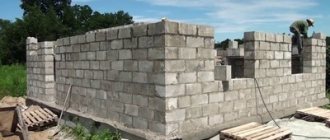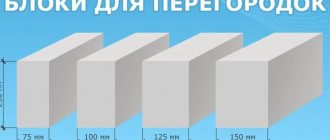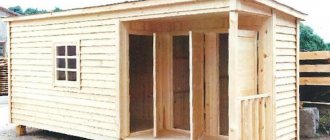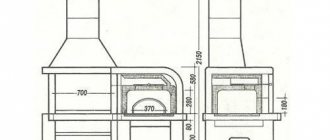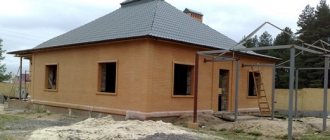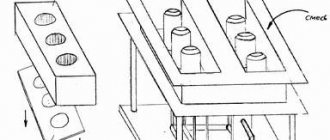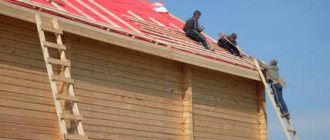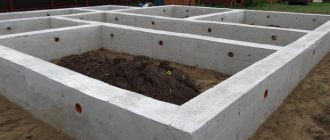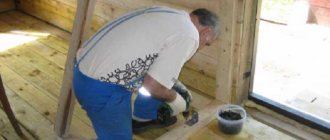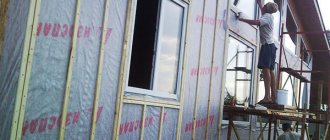X
Now wood concrete is gaining popularity again. Is it really justified, and is it true that the blocks can be made independently? It’s worth trying to answer these questions more or less objectively.
The very fact that the second name for wood concrete is wood concrete cannot but arouse interest in the technical characteristics of this material.
Its properties, on the one hand, provided arbolets with a number of specific areas of application, and on the other, did not allow it to compete with large-sized panels at the end of the last century.
RECOMMENDED ON THE TOPIC
- What is Art concrete (decorative plaster)
- What is isolon?
- Portland cement: what is it?
History of invention
It is believed that wood concrete was originally conceived as a Soviet analogue of a foreign material with similar composition and performance characteristics.
It is curious that the Dutch “source code” was widespread in Europe and the USA already in the 40s. This was explained by a successful combination of properties - environmental friendliness, high insulation performance and lightness played a role.
Wood concrete house - 50 years later
In the 60s, wood concrete was officially documented, the requirements for raw materials and its production technology were successfully standardized. Despite the impressive volumes of production, buildings from such blocks were built mainly in the northern regions, and these were mainly buildings for industrial or specialized purposes.
During the construction boom, the first half of the 90s, wood concrete was ignored (is it fair?), giving preference to panel technology. And soon the factories that produced the material either cease to exist or change their profile.
Of course, wood concrete has its drawbacks. However, one should not ignore the fact that buildings built from it in Soviet times have retained their appearance and performance qualities to this day.
Production technology
Wood concrete occupies a strictly defined place in the classification of concrete, being a light, coarse-celled variety of the latter. Cement is used as a binder in its production.
The composition of raw materials for the production of wood concrete blocks is as follows:
- wood chips, calibrated according to GOST. The standard recommends using waste from woodworking enterprises with dimensions of no more than 40*10*5 mm (even better than 25*5*3). This is how wood concrete differs from sawdust concrete or fire concrete;
- cement grade M400 or M500. The second option is preferable, since even when leaving the manufacturing plant, the cement already loses a little of its strength properties;
- water without impurities (not technical);
- chemical additives. Can be used: calcium chloride, aluminum sulfate, liquid glass (silicate block), calcium nitrate. The main purpose of the application is to promote the hardening process, which additionally affects the biostability and water permeability of the finished blocks.
Strictly speaking, it is possible to use wood concrete in construction without going through the process of forming blocks. The resulting mixture is simply poured into the fence on site. If slabs or wood blocks are required, then the technology is as follows:
- The chips are poured into a forced-action concrete mixer (gravity concrete mixers are not able to provide the required homogeneity).
- Mineralizing additives are dissolved in water, separately from the wood chips.
- The solution is spread evenly over the surface of the wood filler and mixed for 20 seconds.
- Cement is added, after which the concrete mixer must run for another three minutes so that the composition is completely homogenized (leveled).
- Now it's time to shape the blocks. This must be done within 15 minutes of final mixing.
Forming can take place either manually (with or without vibration) or on a vibrating machine, with additional compaction possible.
The primary task of pressing is not to deform the chips, but to ensure a uniform block structure.
Only strict compliance with GOST standards when selecting raw materials and production can ensure the required technical characteristics of the material. Accordingly, it is possible to evaluate the quality of wood concrete only based on the operating experience of certified products purchased from a reliable manufacturer.
What is needed to build walls?
You can purchase ready-made elements and then you will only need:
- Bucket - for solution.
- Trowel or spatula - for applying the solution.
- Shovel - for mixing the adhesive mixture.
- Tape measure - for measuring sizes.
- Hacksaw – for cutting products.
- Level and fishing line - to check the evenness of the plane.
- Rubber hammer - to adjust the evenness of the laid element.
- Adhesive mixture.
If you wish, you can make wood concrete elements with your own hands. And you don’t need to have special industrial equipment for this.
For independent production, you need to prepare or purchase:
- Concrete mixer.
- Metal tray - for the finished solution.
- Forms - for pouring the solution and hardening it there.
- Separator – for filling several elements in one form or creating voids in elements.
- Vibrating sieve.
Consumables needed:
- Organic filler (chips, sawdust, straw).
- Cement.
- Water. Must have a temperature between 15°C and 25°C. Its amount should not be more than half the weight of the added cement, otherwise the material will not be strong.
- Chemical additives (aluminum sulfate, calcium chloride, liquid glass, sodium silicate, slaked lime).
Note : the approximate consumption of materials per 1 m3 is 250 kg of organic filler, 250 kg of cement, from 8 to 10 kg of chemical additives.
Advantages of using arbolite blocks
Depending on the density, this type of concrete can be optimized to perform one of two functions in a future building:
- thermal insulation;
- structural.
Lower density values (from 400 to 500 kg/m3) indicate that such blocks are good for thermal insulation of walls, but will not be able to withstand the load from the roof. High (from 500 – 850 kg/cub.m) are typical for blocks that are more durable, but inferior in insulating qualities.
This feature of the material should be taken into account when talking about its pros and cons. Speaking of the first ones:
Scope of application : load-bearing walls of buildings up to three floors high, construction of utility rooms. The material is suitable for individual construction. The “thermal insulating” version of wood concrete will help retain heat even with existing load-bearing walls.
Compressive strength – 0.5 -5 MPa (the average value of 25 kg/sq.cm is not fundamentally different from other cellular concrete), the exact value is determined by the class of wood concrete. In addition, the blocks are able to restore their shape after temporary deformation from load, completely or partially. This is due to the plasticity of the organic filler.
Flexural strength - this characteristic of the material distinguishes it favorably from foam or aerated concrete. If an uneven load occurs (for example, the foundation sits unevenly), then the blocks are simply slightly deformed, but cracks and destruction do not occur.
Thermal insulation properties are another clear advantage of wood concrete. According to GOST, the recommended thickness of walls made from these blocks is 38 cm. However, even laying them in one row, with a resulting wall thickness of 30 cm, will ensure heat loss at the level of a brick wall one meter wide. Therefore, having built a house from wood concrete blocks, you can definitely forget about unnecessary heat loss.
Perlite: what is it and insulation characteristics
Frost resistance - the material is able to withstand 25-50 freeze/thaw cycles. The indicator is not bad, even taking into account the spread, the responsibility for which lies with the individual block manufacturer. This is especially important for country houses that are heated occasionally or not heated at all. The use of wood concrete will allow such a dacha to be used for at least 25 years.
Vapor permeability - blocks absorb moisture well (which is precisely their disadvantage). But they do not accumulate water vapor - the material will not get wet even in conditions of high air humidity.
Sound insulation properties - the sound absorption coefficient of wood concrete in the range from 126 to 300 Hz is 0.17-0.6. Even compared to “related” wood (0.06 - 0.1), blocks are a more advantageous option. Brick walls will dampen sound several times worse.
Lightness - the use of blocks in total allows you to reduce the weight of the structure by 3 times compared to brick, and 1.5 times compared to expanded clay concrete (the numbers are approximate, it all depends on the thickness of the masonry). This not only simplifies the construction work, but also allows you to save on the foundation.
Resistance to fire - the blocks belong to low-flammability materials (group G1), they also ignite poorly (group B1). According to the degree of smoke formation, wood concrete belongs to group D1 - smoke is produced during combustion, but in small quantities. Based on the totality of properties, the material can be called fireproof.
Biostability and environmental friendliness - arboblocks are not prone to rotting and mold. Manufacturers claim that the material does not contain mice, although this statement is sometimes disputed. The composition of the blocks does not imply the release of harmful substances into the environment.
Ease of installation - sawing blocks is not difficult. In addition, the structure of the material perfectly accepts fasteners (nails and screws) and allows plaster to be applied without additional reinforcement.
Cost-effectiveness - the use of wood concrete allows you to reduce a number of costs associated with transportation, construction, payment of hired labor, as well as reduce home heating costs.
Overall performance qualities make it possible to build from wood concrete not only summer cottages and outbuildings, but also houses designed for permanent residence. The only “but” is that you will need to take into account and neutralize a number of negative aspects.
How to build the walls of a house with your own hands?
Before starting masonry work, it is recommended that you read the brief instructions in general terms:
Preparatory stage .
At this stage, the thickness of the walls is determined: if the climate is mild, then a thickness of 30 cm will be sufficient. If the weather is harsh in winter, then the thickness of the walls is increased. It is better to lay arbolite blocks flat: laying on an edge is also allowed, but for the construction of sheds and utility rooms.Before starting work, prepare a solution, but do not prepare it in large quantities for future use, otherwise the glue will begin to harden while still in the bucket. It is recommended to prepare enough mortar to lay 1-2 rows. This indicator depends on the speed of the wizard.
- Installation of 1 row .
The first row must be protected from moisture - special hydrophobic materials are used for this. Apply 5-6 mm of solution with a ladle and level the layer. You need to understand that some of the solution will seep into the wood concrete chips and the thickness of the solution layer will be less, about 3 mm. The correctness of the laying of the corners is checked with a square. A cord is pulled between the corners, which allows you to lay out the row evenly. - Installation of 2 rows . After laying 1 row of wood concrete, you need to wait at least 4 hours. Then you can begin work on the construction of 2 and subsequent rows. A reinforced mesh is placed on the first row of sides for strengthening and the laying continues from any place: it is not necessary to start laying stones from the corners.
The size of the seams in each row should be the same, and the blocks should lie strictly horizontally without slanting to the side.
Find even more information about laying wood concrete walls here.
Disadvantages of arboblocks
It should be noted right away that some of them may not manifest themselves at all, others depend on the manufacturer, and some are simply uncritical:
- A large selection of “handicraft” products - casting blocks for your own needs or for sale is not prohibited, and the technology in general is not so complicated. But, without experience and some knowledge, it is impossible to ensure that the blocks comply with the standards; the amateur even tries very hard. But you can’t always buy factory-made wood concrete and not everywhere.
- High cost - insufficient automation of production, sometimes “crude” technology and type of raw materials - these factors lead to the fact that wood concrete is one and a half times more expensive than aerated concrete or foam concrete.
- Water permeability - the material, as already mentioned, is capable of absorbing a lot of moisture, so a special plaster coating and waterproofing separation of the walls from the foundation is necessary.
- Low accuracy of geometric dimensions - even factory-quality blocks are guilty of this, let alone products from craftsmen. When performing this, this forces you to increase the thickness of the masonry joints or change the special perlite solution. Perhaps this drawback can be eliminated by introducing surface milling operations into the technology, but for now the problem still exists.
- Limitations in the finishing of walls - since the wood concrete itself absorbs moisture, but is non-hygroscopic and breathable, the final finishing materials must be vapor-permeable.
The disadvantages can significantly affect the material benefits of using wood concrete. The material simply may not be as budget-friendly as it seemed.
Difficulties and errors
Inexperienced builders performing work for the first time often encounter difficulties and make mistakes.
The most common ones are:
- The use of cement-sand mortar for the entire masonry will result in the presence of cold bridges - it is better to use glue or perlite mixture.
- Lack of reinforcing belt. The material requires strengthening, otherwise cracks will appear on the walls.
- Use of materials that do not meet standards.
When choosing wood concrete, you should not succumb to too low prices: most likely, this indicates the low quality of the material. The use of such blocks will lead to negative consequences for the integrity of the house.
Making blocks yourself
At first glance, everything is simple - the technology is obvious, and the savings are noticeable. However, this is a theory, but in practice you may encounter the following problems:
- The presence of nuances is the main reason that the production of high-quality wood concrete blocks at home is hardly possible. A simple example: adding sawdust and impurities to the mixture is acceptable, but will require correction of the technology (changing the amount of mineralizing substances and the degree of compaction).
- Basic preparation of raw materials - 90% of the base should be wood that has passed through a crushing machine, otherwise the result of production will not be wood concrete, but sawdust concrete. And this is a material with completely different strength and thermal insulation characteristics.
- The need to use special additives - calcium chloride or aluminum sulfate may not be on hand; you will have to be content with a solution of slaked lime. The wood chips need to be soaked in it for at least 3 days. You can even replace the chemical neutralization of sucrose by keeping the chopped wood in the open air for 3 months.
- The need for special equipment - a concrete mixer and a vibrating table will still have to be purchased. You may also need a drying chamber and molds for casting.
There is an opinion that the use of lime as a mineralizing additive negatively affects the technical characteristics of the resulting blocks.
In general terms, the sequence of actions when making wood concrete blocks with your own hands is as follows:
- It is better to start six months before construction - taking into account the exposure of wood chips to air and the period of cement hydration. For the latter, by the way, it will be necessary to keep the finished blocks at a temperature not lower than +12 degrees for 2-3 weeks.
- Prepare areas for mixing and settling blocks. For the second you will need to build a canopy.
- Make or buy wood chips. For the first test, the second option is even preferable.
- It is still advisable to try to purchase special additives to avoid the hassle of aging wood chips or lime.
- When the finished mixture has already reached homogeneity in the concrete mixer, you can check it by squeezing it in your fist. The lump should keep its shape, not flow or fall apart.
- Now the wood concrete can be poured into the vibrating machine mold.
- The molded blocks are placed under a canopy for 3 weeks to gain strength.
Proportions of concrete for the blind area around the house
Types and sizes of blocks
The main advantage of using wood concrete blocks in construction is the variety of shapes and sizes. Factories and workshops involved in their production produce blocks of varying dimensions, sizes and shapes. This is due to the ease of technology: the mold for their production is constructed by welding sheets of iron. The most common size is 500*200 mm, thickness from 100 to 500 mm.
In the table you can see examples of sizes:
Looking at the table, you can appreciate the variety of sizes and thicknesses, and this indicates the ease of selecting blocks both for load-bearing walls and for partitions between rooms. Arbolite blocks, if desired, can be made independently at home. This is quite real. This way you can choose the desired shape and size directly for your building.
What you will need for construction: consumables and tools
In addition to the building material for the walls and the adhesive composition or cement-sand mortar that will be used to erect the structure, you will also need tools :
- building level;
- cord for installing plumb lines and beacons;
- spatula for applying glue;
- square;
- Master OK;
- drill with a nozzle for stirring glue;
- buckets - for water and for solution;
- ladle-trowel;
- chainsaw or hand saw, i.e. everything you can use to saw wood concrete blocks;
- roulette.
Using a building level and plumb lines, as well as beacons, the master checks the evenness of the masonry. For example, to lay out the first row, you need to pull the cord so that the stone is laid according to its line.
Then, using a building level, the evenness is checked again horizontally and vertically. To apply the glue, use a trowel or a wide spatula with teeth - it evenly distributes the mass over the stone. Using a square, they check the evenness of the corners, and a chainsaw is necessary so that you have something to cut the blocks with. A tape measure will also be useful, with which you can check the masonry diagram.
Small reinforcement mesh or metal reinforcement bars may also be useful. They are needed for reinforcing and strengthening walls.
Wood chips: how to get or where to buy
Common sense will help in this dilemma: for what scale is production planned? The fact is that the equipment will not pay for itself if a one-time and small construction is planned. But if a large construction is planned, then it makes sense to purchase machines. The main thing is to correctly assess the scale of construction.
The stages of production are:
- Selection of wood;
- Production of raw materials using specialized equipment (machines);
- Mineralization (gets rid of sugars).
For wood concrete, the best choice would be coniferous wood chips due to their low sugar content: pine, fir, larch, spruce. According to GOST, chips of poplar, birch, aspen, beech are also acceptable, and if it is not possible to use wood, stalks of cotton, hemp, and rice straw are used.
The following requirements apply to wood chips:
- Sawdust sizes up to 40*10*5 mm. According to professionals, the optimal chip sizes are about 25*5-10*3-5mm;
- No rot or mold;
- Bark no more than 1/10;
- No foreign matter: dust, sand and small debris are removed using a sieve.
From waste wood passed through special machines, the chips obtained are exactly as required. It should be needle-shaped; in addition to wood, bark can be used, but not more than 5% of the total volume.
Chip production equipment:
- Chip cutters. They are also called chippers. The difficulty is that not all such machines produce the required size of chips; further grinding is required;
- Rotary knife crushers. A good option. The only caveat: the knives need to be changed as they grind, they do not sharpen;
- Fork choppers. This equipment, despite its high cost, is more suitable, since it produces certain sizes of chips.
Next comes processing in one of the possible ways:
- physical - rinsing with water;
- chemical - mineralization with soaking in a solution of calcium chloride, washing with liquid glass;
- biological - heating the wood chips to accelerate the fermentation processes and the removal of sugars or by combining them.
When deciding in favor of a purchase, pay attention to wood concrete manufacturing plants, wood processing and logging enterprises: here you can purchase wood chips more profitably.
How to lay wood concrete blocks
Wood concrete is wood chip concrete, the strongest of lightweight concretes based on organic filler. Mixtures can be used for laying blocks:
- Cement-sand. Not the best alternative for the construction of residential buildings due to high heat conductivity. But in cases where heat preservation is not a priority (building a garage, shed), the use of this mixture is acceptable.
- Perlite mixture is a finely dispersed volcanic rock, blocks based on which retain heat well and are more acceptable in residential construction.
- The ideal option is considered to be adhesive for cellular concrete - durable and economical, working with this composition is easier than previous options.
Step 1
Laying waterproofing - most often 2 layers of roofing felt - on the foundation (this step protects against moisture getting into the blocks). Lay the material 10-15 cm wider than the thickness of the future walls.
Step 2
Start installation from the corners. Using a trowel, apply the masonry mortar, the layer thickness is about 6 mm (part of the composition will go into the cavity). Check the correct level and, if necessary, adjust the block using a rubber mallet.
Step 3
Set the installation level for the entire row: this is very simple to do with the help of a string stretched between the blocks from the outside.
Step 4
Apply the solution to the vertical edge from the end, install the second block tightly into the joint, and then follow it according to the same principle with the next one.
Continue this algorithm of actions until the end of the row. If you need to adjust the block to size, use a saw and immediately treat the cut area with an antiseptic compound suitable for wood. After laying the row, the basic rule is to take a break for several hours (at this time the solution will set).
Step 5
Laying reinforcing mesh on blocks of the finished row. Its further use is mandatory every 3-5 rows.
Step 6
Continue installation, applying the solution to the horizontal surface and to the end parts. Installation involves bandaging and periodic monitoring of the structure level. After installing the first row, it is not necessary to start from the corners.
One of the undeniable advantages of wood concrete blocks is the ability to saw them if necessary. It is almost impossible to accidentally damage such building materials. When cutting where chips are exposed, treatment with an antiseptic is required to prevent hidden problems in the future - the formation of mold and rot. A house made of wood concrete does not need a frame, unlike construction from materials that require shrinkage. The unpretentiousness of the blocks when stored in winter is also a significant plus.
The ability to make building material with your own hands is the main characteristic that distinguishes it from other types of blocks.
If you weigh all the pros and cons when choosing, based on reviews from real home owners, then positive opinions will still prevail. People already living in these houses note good thermal insulation, which is a significant advantage for the harsh Russian winters.
Cement mortar: find out how to mix it correctly
Below are the opinions of builders, where you can get acquainted in more detail with the positive and negative properties of wood concrete blocks.
Difficulties in work and possible errors
To avoid the formation of cold bridges, you need to choose blocks that are made strictly in accordance with GOST. The deviation from the set values should be a maximum of 5 mm. A poorly made block can shrink over time, which can lead to curvature and deformation of the wall surface.
Arbolite blocks
cannot be treated or insulated with a vapor-proof material or tiles placed on top of them, otherwise the moisture coming from inside the house will try to escape through the walls to the outside, but will not be able to.
The result is the accumulation of moisture in the elements, the formation of mold and mildew.
The base should not be filled with cellular concrete , otherwise dampness and moisture will penetrate through it into the walls.
If the work is done independently, then due to lack of experience, you can lay out the walls crookedly and fail to maintain the distance between the blocks. And this will lead to loss of appearance of the masonry.
Before installing the roof, it is important to make an armored belt over the last row , otherwise the load on the walls will not be evenly distributed, and the blocks will begin to deform.
Positive feedback from builders
Sergey, builder.
I am builder. I love working with wood concrete; the material is not capricious and easy to process. Wood concrete blocks do not require a powerful foundation; a strip foundation on a sand backfill is suitable. He built his own house from arbolite blocks. I can say that I didn’t even use reinforcing mesh, the house is more than five years old and the finishing in none of the rooms has deteriorated, not a single crack on the walls. I'm happy with the choice. Another plus: it’s easy to drill into walls, you can screw in screws without dowels.
Albert, foreman
I read reviews on the Internet and am surprised. I won’t say anything bad about wood concrete, no matter how long I worked with it. People themselves save where they don’t need to. On a cement mixture, for example. Before building, it would be good to delve into the topic, then all the benefits of wood concrete can be easily obtained and then you can save on building a house. Among the advantages of working with wood concrete panels, I especially want to note their convenience in the construction process - if there is excess left, you can simply saw it with a grinder and adjust the dimensions.
Features of construction from arbolite blocks
You can build a building from wood concrete not only for residential use. Very often this material with organic filler is used for the construction of walls :
- basements;
- garages;
- baths
Each type of structure has its own masonry features.
Cellar
The basement is used for household needs: winter supplies or items needed in everyday life are often stored in it. For the cellar, it is important to ensure that there is no moisture, since if the basement walls are covered with condensation, this moisture will soon seep into the main part of the house.
There are several features of constructing a cellar from wood concrete:
- it is allowed to build a cellar under a ready-made house by making a excavation in the ground: in this case, it is necessary to conduct a study and find out whether the cellar will affect the integrity of the house:
- the pit is dug manually, without the use of machinery;
- first the floor is installed, then the walls;
- when constructing walls made of wood concrete for a cellar, 2 holes for ventilation pipes must be provided;
- waterproofing is applied to the walls made of wood concrete and the soil around them, more often - roofing felt.
Cellar walls made of wood concrete blocks can be treated with lime mortar or antiseptic. If desired, they can be plastered.
Garage
A garage should be a secure structure in which a vehicle can be safely stored. The building must also be fireproof and made in such a way that the car owner can conveniently operate his vehicle: leave, drive in and carry out maintenance.
When constructing walls for a garage from wood concrete, the owner receives a monolithic wall from which not a single block can be knocked out, which ensures safety.
Several features of building a garage from this material:
if there is a hole in the garage, then before installing it you need to check the groundwater level;- walls made of wood concrete must be waterproofed;
- be sure to design a garage before construction;
- when building from wood concrete, there is no point in making a deep foundation for a garage, so a strip foundation is sufficient;
- the platform for the car can be made of concrete or paving slabs;
- a depth of 1 meter will be enough for a trench for a garage;
- masonry, as in other cases, begins from the corners and the horizontal lines are constantly checked.
During the work, the installation of an opening beam will be required. It is often made of reinforced concrete, but such a design will place excessive stress on the wood concrete. Instead, it is better to use the blocks themselves, having previously tied them with reinforcement.
Bath
Wood concrete is the best material for building a bathhouse. during the construction process , thanks to which craftsmen choose this particular material :
- the warmth and fire safety of the bath will be ensured due to the composition of the blocks;
- it is better to use monolithic technology: such a bath will be warmer;
- the components of the adhesive mixture must be prepared before starting all work;
- It’s better to work with two or three people;
- if the bathhouse is small, then you can do without a team of workers and do everything on your own;
- It is better not to use homemade wood concrete blocks.
Many experts insist on building a bathhouse from monolithic wood concrete, but if the technology and rules are followed, block material can also be used for construction.
All the nuances of building a bathhouse from arbolite blocks are here.
Negative reviews
Sergey, representative of the manufacturer.
The downside is that there are a lot of fakes and low-quality products on the market. I think due to the growing popularity of wood concrete. The manufacturer must be verified and comply with GOST standards. Otherwise, if you use low-quality wood chips or low-grade cement, the result will be appropriate. They also churn out things for speed and don’t follow the technology. Hence the consumer outrage. Choose your supplier wisely or your own production.
Veronica, engineer.
In my experience, there are many projects of houses made of wood concrete. I can say that there are some nuances with plastering walls, due to the porosity of the material. Select the solution carefully and do not violate the technology, otherwise the plaster will come off quickly.
Pros and cons of self-building
Laying any material yourself is always cheaper than hiring specialists for this work. The situation is exactly the same with wood concrete:
- If you make the blocks yourself and then lay them, you can significantly save your budget.
- This material is very easy to work with. Even a beginner can quickly master the technique of masonry, as well as learn how to process or trim it.
However, you can get several disadvantages from laying it yourself . If you do not know the masonry technology, do not comply with the proportions and storage conditions of the material, the result will be disastrous:
- During the cold season, it is important to work very quickly, mix the glue indoors in small portions and use only warm water.
The blocks should not be laid out in rows, but in short sections of 5-7 blocks so that the solution has time to harden and not freeze.
A novice or inexperienced builder may not know these requirements, so the quality of the masonry will be lower.- Also, the products must be covered with film to prevent moisture or melted snow from getting inside the elements.
- If you cut the blocks incorrectly or ineptly, you will have to spend more adhesive mixture and finishing plaster to level the surface.
Reviews from home owners
Opinions from owners of houses built from wood concrete blocks. Most of them are satisfied, but there are also contrasting opinions.
Positive
Arseny, lawyer.
I'm building a house. When choosing building materials, I decided to use wood concrete panels. After monitoring the market and reading reviews, I chose a company that produces high-quality wood and wood chips itself. Cement is used directly from the cement plant.
I like that there are few seams and the geometry is easy to control. The slabs are plastered. I advise you to take into account the minimum thickness of the slabs, depending on the region. It's best to take it with a pass. Buy wood concrete only from a reliable manufacturer, or make it yourself.
Vladislav, bank employee.
A huge plus is that wood concrete is similar in quality to wood, the material is breathable and reliable. But at the same time, unlike wood, it does not burn, does not shrink and is not afraid of pests. Thermal conductivity is also good and it does not need insulation. You can build from panels or from blocks.
Negative
Victor, designer.
When building a house from wood concrete, on the advice of the builders, they did not reinforce the walls on the second floor. The developer probably decided to save money in this way.
Later it turned out that it was necessary to reinforce the belt between the floors. A lightweight reinforcing belt (plastic mesh) is sufficient, otherwise there may be distortions.
Anatoly, businessman.
I would not recommend building a large house from wood concrete slabs if you live in a humid climate. The material is porous and easily absorbs moisture. And in other regions, do not delay with interior and exterior decoration to avoid destruction from the inside. The manufacturer honestly indicates everything on the packaging, it’s a pity I didn’t pay attention to this in time.
House made of wood concrete. Family and simple life in the village. BuildJunk.
Laying arbolite blocks: systems and methods of performing work
Construction from arbolite blocks
The process of work and laying arbolite blocks is not a complicated construction process. Especially if you know the characteristics and properties of the wood concrete itself.
What are arbolite blocks made of?
At the moment, the use of the material in construction has become quite common. This is due to the fact that the material has high technical performance and its own specific composition.
Wood concrete consists of:
- Made from sulphate cement.
- Portland cement.
- Binders.
- Shavings, sawdust and so on.
- Cellulose raw materials.
- Mineral enzymes.
- Chemical additives.
- Liquids.
- All materials have been tested for strength and reliability.
- They are used in a certain quantity.
- Wood concrete is produced only in special factories.
- But, it is possible to do it at home using equipment.
- To do this, you will need all the above ingredients and instructions.
The process of making raw materials yourself is quite a complex process, and you need to have certain knowledge in this area.
Technological features and material properties
Features of the material and characteristics
It has long been established that wood concrete blocks are the most optimal solution for the construction of a residential building. The price of this building material is affordable, which makes it possible to use it for other purposes.
Let's take a closer look at why?
- Arbolite blocks have a large porous structure.
- Thanks to this, it is possible to maintain a constant temperature in the room.
- The air humidity in the building is also at the same level (with proper operation of the building).
- In terms of their properties and characteristics, arbolite blocks are somewhat similar to the properties of wood.
Properties of arbolite blocks:
- This material is environmentally friendly, as it does not contain synthetic substances and elements. It is made only from pure raw materials.
- Wood concrete is not exposed to fire. This ensures the safety of the building in case of fire.
- The blocks have non-standard sizes, which greatly help to build a house quickly and easily.
- They have less mass than bricks. Thus, there is no load on the foundation of the house.
- Despite their light weight, the blocks can withstand significant loads and are able to support any type of roof (on a wooden or metal frame).
- Arbolite is quite easy to cut.
- Due to their structure and composition, the blocks breathe, and thereby ensure a favorable microclimate in the room.
- The material has a high thermal conductivity, which makes it possible to do without additional insulation.
Since the structure of wood concrete is porous, it is recommended to do its internal and external finishing. So that the pores do not absorb moisture and transfer it into the building.
- The most important property of wood concrete is that its structure and composition are not susceptible to decay, which cannot be said about wood.
- The material easily tolerates any climatic and weather conditions. Its structure does not change from such influence over a long period of operation.
Some professionals argue that only one-story buildings and outbuildings can be built from wood concrete. This is wrong. Wood concrete is a durable and reliable building material, and multi-storey buildings made from it will be in use for at least 50 years.
- Arbolite is not afraid of frost. He is not afraid of temperature changes. Even if the house is not heated for a long time, then in a short period of time it is possible to create an optimal temperature, since the air in the room will immediately warm up, and not the walls.
Types and brands of wood concrete blocks
Brands of arbolite blocks
Currently, two types of arbolite blocks are used in construction:
- Thermal insulation.
- Structural.
All of them are divided into brands and subtypes:
- The strength of wood concrete depends on its brand.
- Wood concrete blocks of grade 50 are considered the most durable and reliable.
- All blocks of grades less than 50 can also be used for construction, you just need to correctly calculate the load on the material.
- There are also brands: 5-10-15-25-35.
- Similar grades are used to make not blocks, but arbolite slabs.
- Their range of applications lies in the insulation and insulation of external walls of a building.
Many builders give preference to the first size of arbolite block, since its laying is quite quick and simple, and the size of the material itself contributes to faster construction of the structure.
The second size of material is more suitable for the construction of interior partitions.
Laying arbolite blocks
Laying arbolite blocks
Arbolite blocks are laid quite quickly and simply; all the work can be done independently.
Let's look at the work process:
- Masonry from arbolite blocks is simple due to the size of the material.
- Inside each block there is a thermal break, which provides thermal insulation of the building.
- Each block is laid in 0.5 blocks or 1 block.
Since the size of the wood concrete block is quite large, masonry of 1.5 or 2 blocks is possible only during the construction of multi-story buildings.
Due to the fact that the laying is carried out similarly to brick laying, it is done with your own hands:
- If the thermal break is filled with concrete mortar during the masonry process, the strength of the wall made of arbolite blocks increases.
- There are various technologies for laying wood concrete blocks: with and without filling the thermal break.
If the masonry uses concrete mortar, which fills all the gaps on each block, then it is necessary to carry out external insulation of the structure, since due to the mortar, the blocks will not pass air as effectively as without it.
In terms of their masonry and wall construction technology, buildings made of arbolite blocks are similar to adobe bricks. They have almost the same dimensions and similar properties in use.
In order to lay wood concrete blocks you will need:
- Fill the base of the building, which would correspond to its size and the weight of the roof structure.
- Then a concrete solution is made, into which special additives are added for greater strength.
- The solution itself is made from Portland cement, purified sand and water.
You should not immediately mix a lot of solution with additives, as it can quickly harden and lose its properties.
- The basis for laying arbolite blocks can be: monolithic, pile, columnar foundations.
- These types of foundations are the most optimal for the structure.
- If the building is one-story, then it is enough to use 0.5 block masonry.
- If the structure is two- or three-story, then it is better to use masonry in 1 block.
In both methods it is necessary to do the exterior finishing of the building.
Recommendations for masonry
The tools for masonry you will need:
- Building level.
- Plumb.
- Trowels.
- Container for more convenient use of the solution.
- Grinder with special attachments for cutting material.
- A small-sized reinforcement mesh that can be laid between blocks to hold them together more firmly.
The laying itself is done using concrete mortar and the whole process is similar to brick laying.
Laying should be done starting from the corners of the building. Thus, the load-bearing corner structures will be more durable and consist of solid material.
Laying is done gradually:
- Initially, the solution is applied to the base and blocks are placed on it using a building level.
- They are securely fastened.
- The thickness of the concrete solution should not exceed 15-20 mm.
- Next, blocks are placed on the sides. It is impossible to immediately apply it from above, since the plane of the wall will be disrupted under the weight of the wood concrete blocks.
Each row of the block can be placed only after the first one has been thoroughly secured. It is worth considering that after masonry finishing work will be carried out using frame or brick cladding. It is necessary to make connecting reinforcement in the walls, which is mounted into the decoration and thus connects the wall with the decoration.
The finishing of wood concrete blocks, both external and internal, is carried out using modern facing materials, but here it is worth taking into account the ventilation gap in the work, since the material breathes. In the video you can view the process of work associated with laying the material.
